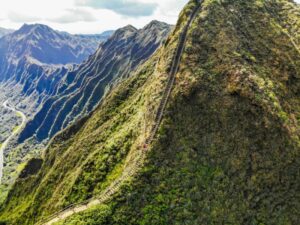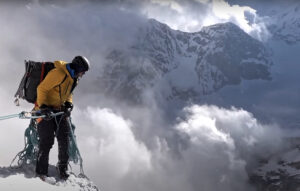The Seven Summits and 8,000’ers aren’t the only popular mountaineering tick lists. The Snow Leopard challenge involves tackling the five highest peaks in the former Soviet Union.
History
The award was established in October 1967 by the catchily named Bureau of the Central Council of Sports Societies and Organizations of the USSR “to establish an honorary badge of the Central Council, awarded to climbers who have climbed all four 7,000’ers of the Soviet Union: the peaks of Communism, Victory, Lenin, and Korzhenevskaya.”

The original Snow Leopard award. Photo: Wikimedia/Skas
The announcement introduces the two most confusing aspects of the Snow Leopard list: the changing names of the mountains and the addition of a fifth “7,000m” peak.
Over the years, the four original peaks have accumulated quite a few names (for convenience I have marked in bold the name we will use for each peak in the rest of this article):
Peak Stalin/Peak Communism/Ismoil Somoni Peak – 7,495m
Peak Victory/Peak Pobeda/Tömür/Jengish Chokusu – 7,439m
Mount Kaufmann/Peak Lenin/Ibn Sina Peak – 7,134m
Korzhenevskaya – 7,105m
Peak Korzhenevskaya, named after the wife of a Russian geographer, has conveniently kept its name. The other peaks are less straightforward.
During the de-Stalinization of the Soviet Union under Nikita Khrushchev, Peak Stalin was renamed Peak Communism in 1962. In 1998, newly independent Tajikistan officially changed the name again. The mountain is now Ismoil Somoni Peak, named after a powerful ninth-century Samanid emir. The new name is quite a mouthful and hasn’t caught on. It remains better known as Peak Communism.
Ibn Sina Peak started life as Mount Kaufmann, after Konstantin Kaufmann, the first Governor-General of Russian Turkestan. In 1928, it was renamed Peak Lenin, and in 2006, the Tajiks renamed it Ibn Sina Peak after the 9th to 10th-century Persian intellectual Abu Ali ibn Sina (known as Avicenna in the West).

A Lenin bust on Ibn Sina Peak, formally Lenin Peak. Photo: Shutterstock
Peak Victory is a little less confusing. Pobeda is victory in Russian and Jengish Chokusu means Victory Peak in Kyrgyz. Tömür is the Uighur name and the official name in China. However, its awkward geopolitical location on the Kyrgyzstan-China border has led to the second confusing element of the Snow Leopard list: Is it four 7,000’ers or five?
In 1985, due to a border dispute with China, the USSR switched Peak Pobeda for Khan Tengri Peak. At 6,995m, Khan Tengri is officially a sub-7,000m peak. But if you include its hat, a 15m glacial cap, it scrapes over the threshold. Khan Tengri has a long list of local names, but thankfully just one official title.
This new list only lasted five years before Peak Pobeda was added back in, creating the modern five-peak Snow Leopard challenge.
Becoming a Snow Leopard
While the Soviet Union collapsed in 1991, the Snow Leopard challenge is still going strong. According to RussianClimb, 697 climbers have completed the challenge (though a handful only completed four of the five, because they didn’t climb Peak Pobeda while it was excluded from the list).
Ivanov Evgeniy was the first to finish, ticking off the peaks in 1961, six years before the program was officially established. The first winter Snow Leopards completed their list just last year. Sergey Seliverstov, Alexey Usatyk, and Mikhail Danichkin knocked over their final winter peaks in August 2020.
Order and Difficulty
Ibn Sina Peak is thought of as the easiest of the five, and the statistics bear this out. Every (COVID-free) year, hundreds summit, making this the most summited 7,000m peak on the planet. Climbers typically make three or four camps up to around 6,400m before pushing for the top. The climbing is not technical, but the uncompromising altitude requires careful acclimatization and caution. The vast majority of climbers on Ibn Sina Peak are guided, and tour packages cost less than $2,000.
Peak Korzhenevskaya and Ismoil Somoni Peak are usually done in conjunction. Korzhenevskaya is the easier of the two and can be used to prepare for its more imposing neighbor. Most climbers take a route up the southern ridge and camp at 6,400m before the narrow summit ridge.

Climbers make their way up Peak Korzhenevskaya, with Ismoil Somoni Peak in the background. Photo: Voldymur Khytrykov
The highest mountain in Tajikistan, Ismoil Somoni Peak shares Korzhenevskaya’s Base Camp at 4,200m. The easiest routes are on the north and west sides of the mountain. But perhaps the biggest challenge is Base Camp hygiene. SummitPost users shared some insightful tips for staying strong: “The best medicine to bypass “Flitzekacke” (the shits) is drinking enough vodka — not kidding.”
Khan Tengri, the lowest of the five, is up next. Base Camp is set up on the mammoth North Inylchek Glacier at 4,000m. The picture-perfect summit pyramid towers above. Most climbers take the west ridge, which can be approached from either the north or south. The southern route is “technically easier but objectively more dangerous.” Khan Tengri is regarded as the third hardest of the Snow Leopard summits after Peak Pobeda and Ismoil Somoni.

Russian climber Alex Volvach near the top of Khan Tengri peak in 2017. Photo: Shutterstock
Peak Pobeda, the most difficult summit, is usually left till last. Notoriously dangerous, Pobeda claimed three lives this season. The most northerly 7,000m summit in the world, it is remote and has a reputation for rapid weather changes and avalanches.






